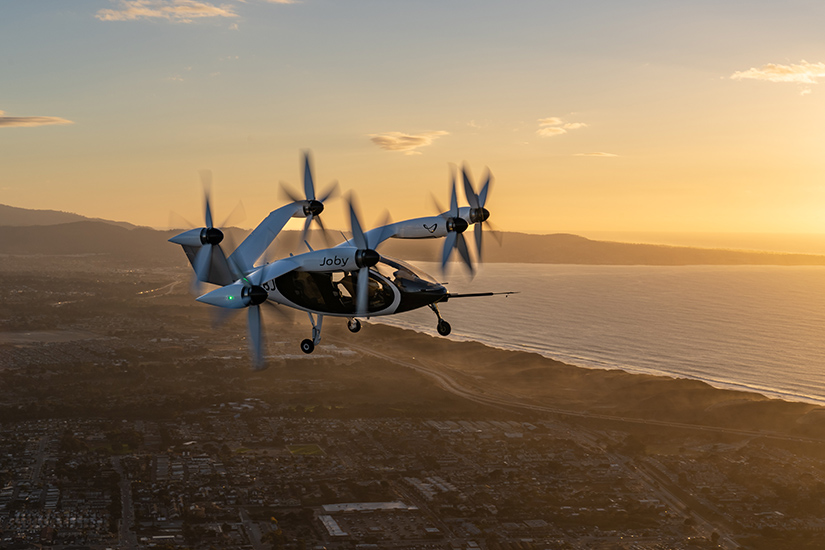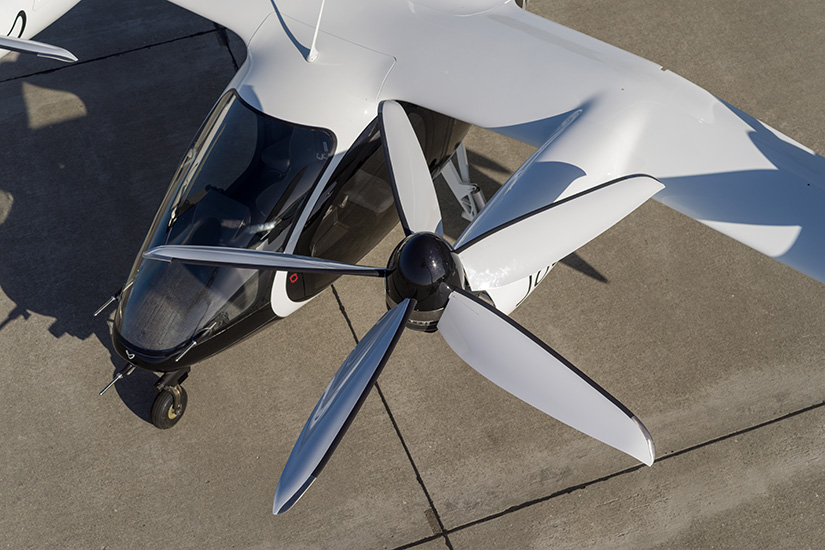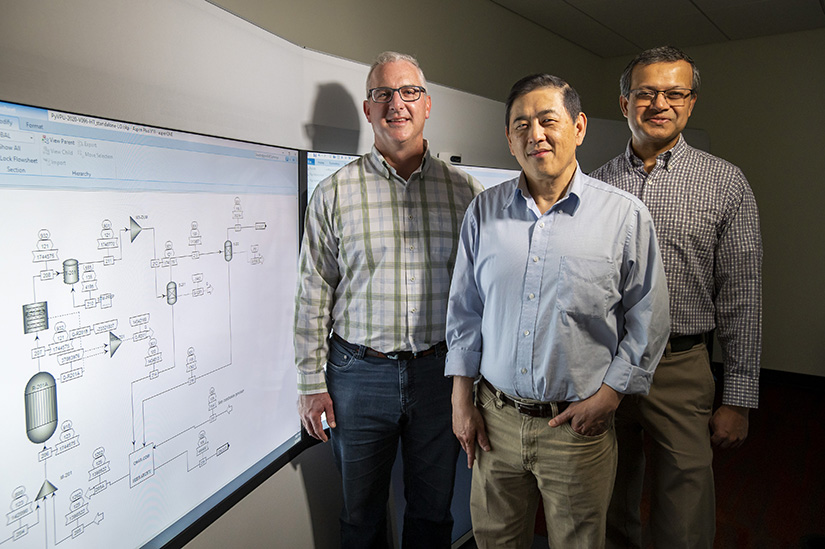NREL and Joby Aviation Partnership Spotlights Green Ride-Hailing Flight Services
Life Cycle Assessment and Blockchain Research at NREL Boosts Sustainability and Decarbonization Efforts for Burgeoning Electric Vertical Take-Off and Landing Aircraft Industry

When Joby Aviation wanted to figure out the environmental impact of its future all-electric aerial ride-hailing service, the National Renewable Energy Laboratory (NREL) helped provide a technological bird’s eye view.
Knowing the potential effect of taking such services to the skies is important for many reasons—logistics come to mind—but learning how aerial ride-hailing could merge with national decarbonization efforts is paramount for NREL researchers.
The transportation sector currently accounts for about 29% of total U.S. greenhouse gas emissions, making it one of the largest targets for lowering the carbon footprint. Further, commercial aviation causes 11% of the overall transportation sector’s greenhouse gas emissions, and its global climate impact is considered even greater because of the cumulative heat-trapping effects of contrails, nitrogen oxides, water vapor, sulfate aerosol gases, soot, and other aerosols.
Aware of NREL’s years of sustainable aviation research, Joby Aviation contacted the Center for Integrated Mobility Sciences (CIMS) for help. The company also sought out NREL’s life cycle analysis (LCA) capabilities and expertise.
“NREL has a long history of leading LCAs in the energy sector,” said Claire Boland, sustainability lead at Joby Aviation. “Having a third party facilitate our LCA was valuable for both parties, as Joby can embed this thinking into our strategic development and ensure it is in line with scientific literature standards, while NREL learned more about the impact emerging aviation technologies can have to reduce emissions.”
Eric Tan, NREL senior research engineer and sustainability analyst, and Raffaele Russo of Joby Aviation teamed up to lead the LCA research study. The results of their partnership were recently published as a chapter in the book Sustainability Engineering, “All-electric Vertical Take-off and Landing Aircraft (eVTOL) for Sustainable Urban Travel."
The NREL partnership reveals how Joby Aviation’s sustainability efforts could help mitigate the global climate crisis moving forward. The case study serves as a model for conducting an LCA for the eVTOL aircraft industry. It also provides guidance to support the development of eco-conscious manufacturing practices and to gain a better understanding of its operational climate footprint. The study looks at its manufacturing processes, how it transports passengers between urban locations, every aspect of its supply chain, and even what happens to the aircraft after it is retired.
“Any service has an impact on the environment, not just in terms of greenhouse gas emissions or carbon footprint but also water and energy usage,” Tan said. “You have to identify the hot spot of the supply chain. You have to find what contributes most to this service’s carbon footprint. Then, researchers and decision makers can design a better and more efficient version to find ways to cut the overall carbon footprint.”
Toward Carbon-Neutral Passenger Flight

Like ride-hailing for the air, Joby Aviation is developing an eVTOL commercial passenger service. With a smartphone app, people could book a ride and get shuttled from one location to a nearby destination—perhaps from the airport to a hotel downtown. It is designed to support flights between 5 to 50 miles across congested cities such as New York, Los Angeles, and London.
As aviation pivots from petroleum-based jet fuel to more green energy carriers, such as low-carbon sustainable aviation fuels, hydrogen, and electricity stored in batteries, there is the potential for deep reductions in life cycle greenhouse gas emissions critical to decarbonizing flight by midcentury.
Joby Aviation reported the goal for its aircraft is to help address both urban mobility needs and support the aviation industry’s transition to climate-neutral flight.
In July, the company released its first environmental, social, and governance report as its service comes closer to launching commercially. Included are overall corporate carbon footprint accounting details, plus the results of NREL’s first comprehensive LCA of both manufacturing and operations for the eVTOL industry.
NREL researchers helped the company quantify its eVTOL aircraft’s life cycle carbon intensity from raw material extraction through operation and identify opportunities to reduce greenhouse gas emissions across its material production, manufacturing, and aircraft operations.
The study also encouraged Joby Aviation to revisit the LCA analysis of the eVTOL service every 18 to 24 months as new information is made available. The methods behind LCA are models for reporting the carbon footprint of flight as a function of aircraft manufacturing, fuel or energy production, vehicle operation, and beyond.
NREL also benefited, as Joby also worked with researchers to develop preliminary guidance for the eVTOL industry on conducting an eVTOL LCA study, particularly on how to define the problem, obtain the right information from engineers inside and outside their own organizations, and what areas to focus on.
“LCA research is a key part of the sustainability of our planet, our humanity. Life cycle carbon footprint assessment is essentially indispensable to mitigate climate change,” Tan said. “The nascent eVTOL industry offers a prime opportunity for LCA to support the development of the technology in a direction that benefits sustainable transportation. LCA studies can offer quantitative knowledge of the impact of eVTOL aircraft design choices on the environmental impacts, including its life cycle greenhouse gas emissions that contribute to global warming and climate change.”

Transparent, Accountable LCAs Critical for the Future of Sustainable Aviation
With so many companies claiming sustainable products, LCAs help quantify those statements by providing a systemic analysis of the environmental impacts of a process, system, or service throughout its entire life cycle.
Tan said the LCA for Joby helps support sustainable manufacturing practices for eVTOLs, provides a better understanding of their climate footprint, and identifies opportunities for improvement. The study also gives examples of how to make an environmental claim and how to report and present the LCA results to a wider audience.
However, he said, quantifying and measuring progress becomes more complex as more sustainable technologies are introduced. Blockchain can help link every part of an LCA for tracking inventory, which is helpful toward understanding the Joby eVTOL and other sustainable aircraft studies.
“You can go back to the beginning of the supply chain. You can track one part from one place and another part from another place,” Tan said. “You want to minimize the uncertainties, so you need to be ultra-transparent and make sure you are completely confident in the source of the data that you use for the LCA. It’s good to have blockchain to keep track of all this.”
Blockchain is a digital accounting technology used to independently verify and track transactions. Although commonly associated with cryptocurrencies and protecting online purchases, the technology can help in other realms. When linked with NREL’s rigorous LCA methodologies, blockchain can help aviation companies to quantify and transact on the impacts and benefits of sustainable aviation fuels and technologies.
According to Brett Oakleaf, a strategic partnership manager for NREL’s Innovation, Partnering, and Outreach Group, such an approach could be core to NREL's aim to permanently lower the carbon intensity of flight services while also fundamentally improving the carbon footprint, mobility, and resiliency of the entire aviation ecosystem.
“The interest and needs of this industry are rapidly increasing,” he said. “Both LCA and techno-economic analysis help companies prioritize and focus projects by cost and ecological impact.”
Learn more about NREL’s sustainable aviation research and how to create targeted solutions for overcoming the biggest barriers to decarbonizing aviation.

